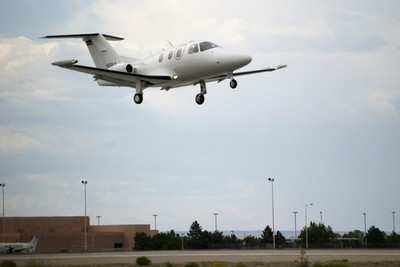Says Company Expects To Deliver "Over 20" Aircraft In July
 By most measures -- make that all of
them -- the first half of 2007 has been challenging for Eclipse
Aviation.
By most measures -- make that all of
them -- the first half of 2007 has been challenging for Eclipse
Aviation.
Faced with a variety of problems -- including revamping the
heart of the Eclipse 500 aircraft, its Avio avionics system; a range of production and supplier
problems, all conspiring to delay volume deliveries of
the 500; parting ways with United Airlines for pilot training; and, most
recently, a VFR-only, two-pilot mandate from the FAA due to a pitot/AOA tube freezing
problem -- Eclipse has, to date, struggled to meet the
lofty performance and delivery promises it made for its
very-light-jet throughout its development.
Those issues have overshadowed the positive developments seen
this year -- including delivery of the first customer
aircraft, and the first jets to its largest customer,
DayJet; and receipt of its production certificate from
the FAA in April. And, fairly or not, the problems have also
given ample fodder to critics of the aircraft... the company... and
its outspoken CEO, Vern Raburn (right).
In his most recent update to customers, Raburn acknowledges
"both the significant problems and very significant progress we
have made." As for good news, Raburn notes flight testing recently
wrapped up on the redesigned pitot/AOA assembly, and the plane
passed with flying colors. Those results are now in the hands of
the FAA for recertification.
"Although I'm glad to report that this problem is behind us
there are lessons to be learned," Raburn writes. "The Eclipse 500
was one of the most tested aircraft to be certified in the last 20
years. We accumulated over 3,400 hours including typical
operational flights using a marketing aircraft. There was extensive
and thorough FAA involvement including approval of the test plans
for the airdata/pitot/AOA system that resulted in an unrestricted
Type Certification of the aircraft.

"Yet this problem was caused by fairly unique meteorological
conditions that went undetected even though we did numerous tests
in Texas, Florida and even the Climate Test Chamber at Eglin Air
Force Base," he continues. "Perhaps the fact that we live and work
in a high desert environment contributed to the problem. So the
fact that the problem went undetected is not the lesson, but how we
as a company have responded to the problem is."
Raburn also notes Eclipse certified 26 planes in the second
quarter of 2007. That's far fewer than Eclipse had planned on, but
a noteworthy improvement over the four planes the Albuquerque,
NM-based planemaker was able to certify in Q1. That numbers is also
higher than the GAMA total for Q2, of 17 planes delivered and out
the door. Raburn says the company considers a plane completed when
it receives its airworthiness certificate; GAMA, when the plane is
out the door.
"As our processes continue to improve the difference between the
two points will decrease," Raburn says, noting Eclipse also plans
to "deliver over 20 aircraft" by the end of this month.

As for performance modfications made to the aircraft throughout
its production run -- including larger, aluminum tip tanks, and a
redesigned tail bullet fairing -- Raburn says "Certification flight
testing is on track to be completed this week, and we are expecting
certification of the performance improvements within the next
couple of weeks." The final certification date will be dependent on
the FAA's approval of the AFM changes and other certification
documents, Raburn adds.
"We have submitted 44 of the 56 documents requiring FAA
approval, and 41 of these are already FAA approved," he continues.
"The remaining 12 documents will be submitted in the next few days.
As previously announced, the new performance numbers have been met
and will be reflected in an updated AFM. The FAA is required to
amend the Type Certification Data Sheet within 30 days of
certification completion. A service bulletin will be issued shortly
after certification and aircraft retrofitting will begin. We are
still on track to cut the performance modifications into the
production line at aircraft 39. In fact, aircraft 39 is currently
in final assembly with all of the performance modifications
incorporated."
Not Even N Numbers Escape Scrutiny
 When it rains, it pours.
Recently, the FAA determined the size of registration numbers on
the Eclipse 500 -- previously approved by the agency to be an
unobstrusive six-inches tall -- aren't large enough, after all.
Raburn details the issue...
When it rains, it pours.
Recently, the FAA determined the size of registration numbers on
the Eclipse 500 -- previously approved by the agency to be an
unobstrusive six-inches tall -- aren't large enough, after all.
Raburn details the issue...
"As part of our type certificate data sheet that we received on
September 30th of last year, the FAA approved six-inch registration
numbers via note 8 on the TCDS," Raburn says. "However, the FAA
reversed that decision and is now requiring registration numbers
that are as large as practical on all Eclipse 500s. Working with
the FAA we have defined a maximum sized area on the tail for the
placement of the N numbers.
"If your N number is something like N1K then the numbers will be
12 inches in height," he adds. "But if your N number is something
like N777WW then the height will be closer to 9.5 inches. Our plan
is to paint the larger registration number on your plane when you
return for the performance modifications. Beginning with aircraft
#29, all Eclipse 500s are being delivered with the larger N
numbers."
And if that's the final issue to plague the Eclipse 500... then
the second half of 2007 might just go a bit more smoothly than the
first for Raburn, and Eclipse Aviation. Stay tuned.
 ANN's Daily Aero-Linx (05.06.25)
ANN's Daily Aero-Linx (05.06.25) ANN's Daily Aero-Term (05.06.25): Ultrahigh Frequency (UHF)
ANN's Daily Aero-Term (05.06.25): Ultrahigh Frequency (UHF) ANN FAQ: Q&A 101
ANN FAQ: Q&A 101 Classic Aero-TV: Virtual Reality Painting--PPG Leverages Technology for Training
Classic Aero-TV: Virtual Reality Painting--PPG Leverages Technology for Training Airborne 05.02.25: Joby Crewed Milestone, Diamond Club, Canadian Pilot Insurance
Airborne 05.02.25: Joby Crewed Milestone, Diamond Club, Canadian Pilot Insurance






